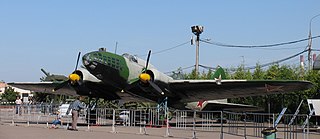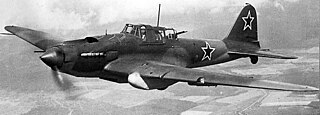
The Ilyushin Il-4 (DB-3F) is a Soviet twin-engined long-range bomber and torpedo bomber, widely used by the Soviet Air Force and Soviet Naval Aviation during World War II.

The Ilyushin Il-2 is a ground-attack plane that was produced by the Soviet Union in large numbers during the Second World War. The word shturmovík, the generic Russian term for a ground-attack aircraft, became a synecdoche for the Il-2 in English sources, where it is commonly rendered Shturmovik, Stormovik and Sturmovik.

The Ilyushin Il-10 is a Soviet ground attack aircraft developed at the end of World War II by the Ilyushin construction bureau. It was also license-built in Czechoslovakia by Avia as the Avia B-33.
The OKB-1 '140', was a jet bomber produced in the USSR from 1947.

The Ilyushin Il-28 is a jet bomber of the immediate postwar period that was originally manufactured for the Soviet Air Forces. It was the Soviet Union's first such aircraft to enter large-scale production. It was also licence-built in China as the Harbin H-5. Total production in the USSR was 6,316 aircraft, and over 319 H-5s were built. Only 187 examples of the HJ-5 training variant were manufactured. The only H-5s in service currently are approximately 80 aircraft which operate with the Korean People's Air Force. The Il-28 has the USAF/DoD reporting name "Type 27" and ASCC reporting name "Beagle", while the Il-28U trainer variant has the USAF/DoD reporting name "Type 30" and NATO reporting name Mascot.
The Tupolev Tu-75 was a military transport variant of the Tu-4 bomber, an unlicensed, reverse engineered copy of the Boeing B-29 Superfortress. The Tu-75 was similar to the Tu-70 airliner, both using a new, purpose-designed fuselage. The first Soviet military machine of this class, it was equipped with a rear fuselage loading ramp. It was not placed into production because the VVS decided it would be cheaper to modify its existing Tu-4s for the transport mission and to use its existing Lisunov Li-2 and Ilyushin Il-12 transports.

The Tupolev Tu-14, was a Soviet twinjet light bomber derived from the Tupolev '73', the failed competitor to the Ilyushin Il-28 'Beagle'. It was used as a torpedo bomber by the mine-torpedo regiments of Soviet Naval Aviation between 1952–1959 and exported to the People's Republic of China.

The Yermolayev Yer-2 was a long-range Soviet medium bomber used during World War II. It was developed from the Bartini Stal-7 prototype airliner before the war. It was used to bomb Berlin from airbases in Estonia after Operation Barbarossa began in 1941. Production was terminated in August 1941 to allow the factory to concentrate on building higher-priority Ilyushin Il-2 ground-attack aircraft, but was restarted at the end of 1943 with new, fuel-efficient, Charomskiy ACh-30B aircraft diesel engines.

The Ilyushin Il-30 was a Soviet turbojet-powered tactical bomber designed as a higher-performance, swept wing version of the Ilyushin Il-28, in the late 1940s. Its thin wing and engine nacelles necessitated the use of tandem landing gear, the first Soviet aircraft to do so. It was apparently canceled before the prototype made its first flight, although sources disagree with this.

The Sukhoi Su-6 was a Soviet ground-attack aircraft developed during World War II. The mixed-power high-altitude interceptor Su-7 was based on the single-seat Su-6 prototype.
The Sukhoi Su-8 or DDBSh was a Soviet prototype ground-attack aircraft of World War II.

The Ilyushin Il-20 was a Soviet prototype for a heavily armored ground-attack aircraft to replace the Ilyushin Il-10. It featured a number of innovative concepts including a cockpit mounted on top of the engine, directly behind the propeller, and wing-mounted autocannon that could be adjusted on the ground to fire level or depressed 23° to allow the aircraft to strafe ground targets while remaining in level flight. However it was slower than the Il-10, and its M-47 engine was problematic in flight tests in 1948–49. It was not placed into production. The test pilots called the aircraft the Gorbach (Hunchback).

The Ilyushin Il-40 was a two-seat Soviet jet-engined armored ground-attack aircraft. The first prototype flew in 1953 and was very successful except when it fired its guns, as their combustion gasses disturbed the airflow into the engines and caused them to flameout or hiccup. Remedying this problem took over a year and involved the radical change of moving the engine air intakes all the way to the very front of the aircraft and repositioning the guns from the tip of the nose to the bottom of the fuselage, just behind the nosewheel. The aircraft, now resembling a double-barreled shotgun from the front, was ordered into production in 1955. Only five production aircraft had been completed before the entire program was canceled in early 1956 when the VVS discarded its close air-support doctrine in favor of tactical nuclear weapons on the battlefield.
The Ilyushin Il-1 was a Soviet fighter aircraft developed during World War II by the Ilyushin design bureau. It was designed in 1943 as an armored fighter for use at low and medium altitudes against the latest German fighters, but by the time it made its first flight in 1944, the Soviets had already achieved air superiority and it was therefore redundant. Only one example was built, but the parallel two-seat attack version led to the successful Ilyushin Il-10.

The Polikarpov R-Z was a Soviet reconnaissance bomber aircraft of the 1930s. It was a revised version of the Polikarpov R-5 which was built in large numbers between 1935 and 1937. It was used in combat during the Spanish Civil War as well as the Winter War and Battle of Khalkhin Gol.

The Chyetverikov MDR-6 was a 1930s Soviet Union reconnaissance flying-boat aircraft, and the only successful aircraft designed by the design bureau led by Igor Chyetverikov.

The Mikoyan-Gurevich I-320 was a prototype Soviet long-range all-weather interceptor aircraft of the late 1940s-early 1950s. Only two were made, with no production following.
The Ilyushin DB-4 or TsKB-56 was a Soviet twin-engined bomber aircraft of the early 1940s. It was a development of the Ilyushin DB-3 and was intended as a replacement for the earlier aircraft, but only two prototypes were built; engine problems and the need to concentrate production on existing types following the German invasion of the Soviet Union in June 1941 meant that no more examples were built.
The Moscow Aviation Institute BB-MAI was a Soviet light bomber/attack plane prototype aircraft. Designed in 1939 by Peter Grushin of the Moscow Aviation Institute, it was delayed by problems with the new Klimov M-105 engine and eventually only a single prototype was built. While the design was not accepted for serial production, it was the first Soviet aircraft to use a tricycle landing gear and one of the first to feature a supercharger and leading-edge slats.
The Ilyushin Il-26 was a late 1940s project for a strategic heavy bomber by the Ilyushin Design Bureau. There were a variety of alternative engines proposed for the Il-26, including the 3,400 kW (4,500 hp) Shvetsov ASh-2TK piston engine and 4,500 kW (6,000 hp) Yakovlev M-501 diesel engine. The specifications varied according to the number and type of engines proposed.

















